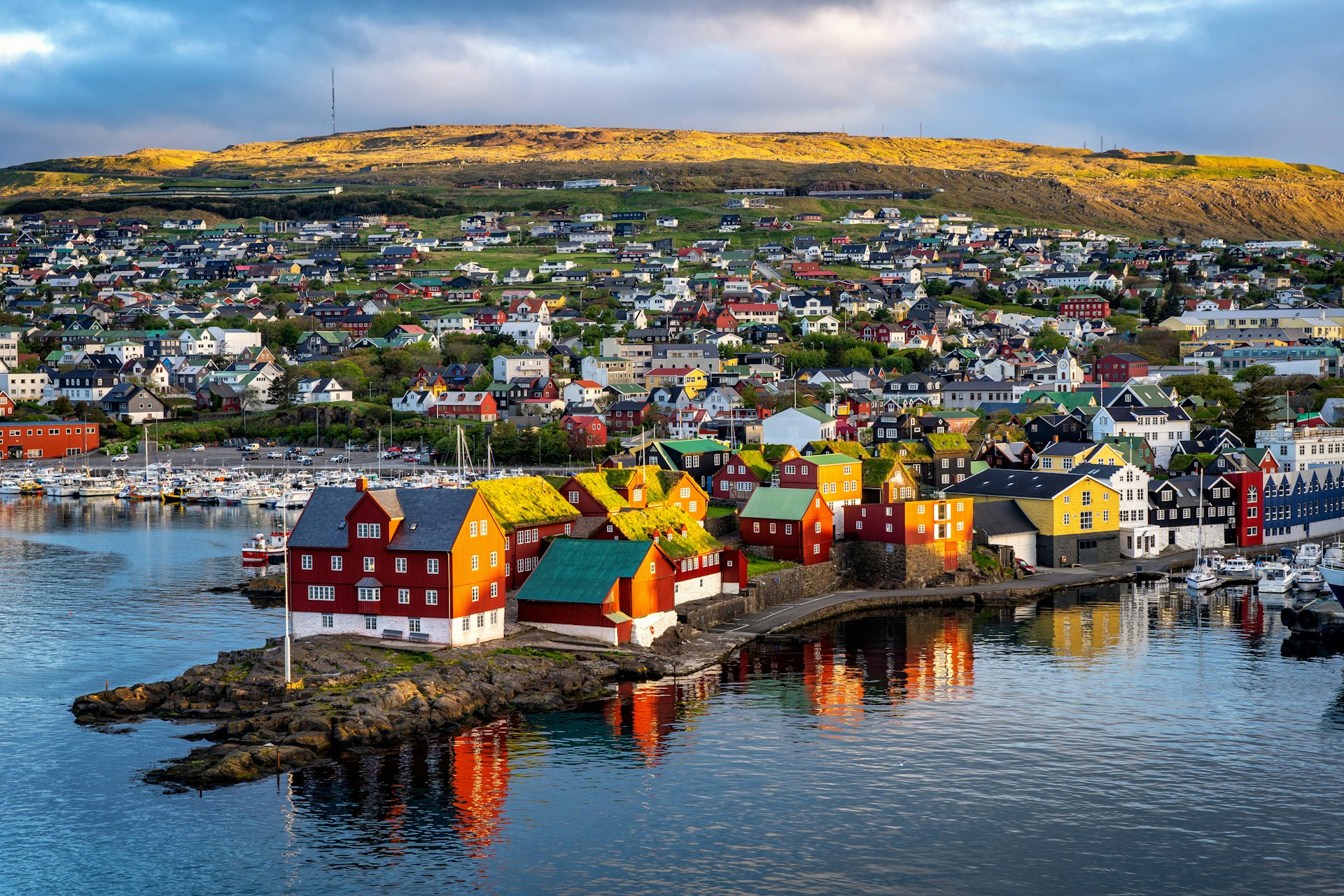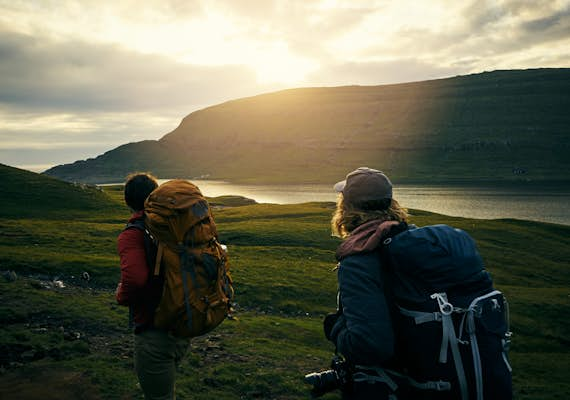Some things will leave you speechless when you arrive in the Faroe Islands: the mountains, the sea view and the price of everything. It turns out that being located in the middle of the North Atlantic – where most things have to be imported – comes at a price, and that price is in Danish krone, the official currency of the islands. The good news is that we have some ideas on how to keep your budget manageable.
In recent years, this off-the-beaten-path location has attracted large numbers of tourists, and their presence has had an impact. Farmers have started adding fees to hiking routes that cross their land, arguing that if visitors leave the trail, they are not only causing damage that they have to pay to repair, they are also walking on the grass that graze their sheep. , which costs them even more. So while you might be shocked to pay for a nature walk here, there is a reason behind it. At the time of writing, there is an ongoing debate about replacing this fee system with a simple tourist tax, which might be easier to use.
Not that the people of the Faroe Islands are unfriendly to tourists – that’s not the case at all. As part of their groundbreaking sustainability program, Closed for maintenanceshows, they open their arms and their homes to visitors who can contribute with them to developing better tourism.
Pay particular attention to unexpected shipping costs. Car rental is reasonable, as is fuel; What you'll add on top of that is a fee for each underwater tunnel you pass through and any ferry you have to take, so be careful when planning your itineraries to manage these extra expenses.

Daily costs
All prices are in Danish crowns.
(For reference: 100 kr = £11.50, €13.50 and $14.50)
- Hostel room: 190 kr
- Basic room for two: 900 kr
- Independent apartment (including Airbnb): 500-2500 kr
- Public transport ticket: 125 kr / day (based on a 4-day pass at 500 kr)
- Coffee: 30 kr
- Sandwich: 55 kr
- Dinner for two: 750-900 kr
- Beer/pint at the bar: 55 kr
- Car rental: from 250 kr / day
- Hiking trail fee: 100-500 kr. Note that more expensive trails usually include a guide.
- Tunnel toll (round trip): 100-450 kr
Average daily cost per person: from 2000 kr
Book in advance and focus on the offseason
This is classic advice for anyone wanting to travel anywhere on a budget, but it's particularly relevant for this group of islands, where accommodation is limited and there's a real chance you'll be able to arrive and find exorbitant prices, nowhere to stay and no car to rent though. you don't plan ahead. It's not uncommon for popular rental properties to be booked up a year in advance. Prices drop during the shoulder season and the cheapest time to travel is October-April. Of course, these months can be less weather-wise for hikers and wildlife watchers.
Avoid July and August if you want to save money
Prices reach their peak in July and August, and peak on July 28 and 29 on the occasion of the Faroe Islands National Day, in Tórshavn in particular. In this part of Europe, summer school holidays tend to take place in July, which can affect flight prices. Again, the best thing to do is to plan ahead and book at least three months in advance.
Traveling in a group
Pooling your resources by traveling in a group is a good way to follow. If you can split the car rental, fuel, tunnel fees and renting an apartment or chalet into four, you'll save a lot.

Take the ferry
Some Northern Europeans choose to bring a campervan and sail to the Faroe Islands via Denmark on Smyril Line ferries. This, at the very least, saves on hosting; you can also bring plenty of food from home. However, ferry costs add up and you have to travel to Hirtshals in northern Denmark to catch the boat. So some additional costs come into the equation.
Opt for an independent dining option
Pack a thermos, book a rental cottage with a kitchen, and shop at a local supermarket (Bónus is the cheapest). If you're really strapped for cash, you can also bring food with you. This way you can avoid high shopping prices.
Consider camping to reduce accommodation costs
You'll probably still need to rent a car and bring plenty of gear with you, but camping is an economical way to travel once you're in the field. Rates at local campsites start at around 100kr per night, and many of them are in picturesque locations, meaning you'll wake up to views of islands, mountains and the sea. Of course, camping depends on the weather and it is not a good idea in winter.
Another saving tip: look for a place to stay outside of Tórshavn. The capital offers the widest variety of places to stay, but prices tend to be cheaper elsewhere.
Reduce your transportation costs by planning and thinking small
The good news is that you don't need a 4×4 to travel the roads of the Faroe Islands. Some roads may seem a little rustic, but at no time will you be driving off-road. It is always cheaper to rent a smaller car, and it is entirely possible to organize a trip there with one. Another savings in terms of driving? Plan your route carefully. With a toll of 100 kr for most underwater tunnels, plus 450 kr for the underwater roundabout, finding a route that reduces the number of unnecessary tunnels you pass through saves money.
The cheapest way to get around is by bus
If you have enough time and patience (and the right clothing to keep you upright during a windy and often rainy stop), the country's public transportation might be for you. Students also receive a 20% discount. Even if you don't plan to tour all the islands by bus, it's worth noting that all red buses in Tórshavn itself are free. Elsewhere, a 500 kr public transport card gives you four days of public transport across the islands, including bus and ferry travel, with reduced fares for children; you can also buy seven days for 700 kr. The deal is good value for money as the bus from Tórshavn to Gásadalur alone costs around 350 kr; the card can be purchased on buses and at ferry terminals across the country.
Some transportation options, like helicopter trips to remote islands, are subsidized and seem cheap, but it's important to realize that they are primarily for local use to keep people connected.

Where to find good, inexpensive food
The best option for cheap restaurant dining is to go to Tórshavn, where you will find a variety of options in terms of cafes, pubs and different price points. Other locations in the islands may be more hit or miss. In particular, look out for fish and chip options, which can fill you up from around 100kr with locally caught fish.
How to travel to the Faroe Islands almost for free
Every year the Faroe Islands have a special weekend called Closed for maintenance. This unique tourism initiative invites around a hundred volunteers to join them for a weekend of trail building, signage and voluntourism. Flights are subsidized and meals and accommodation are provided, making it a very cost-effective option if – and it's a big if – you get a place on the heavily oversubscribed program. Registrations generally open in September each year.


